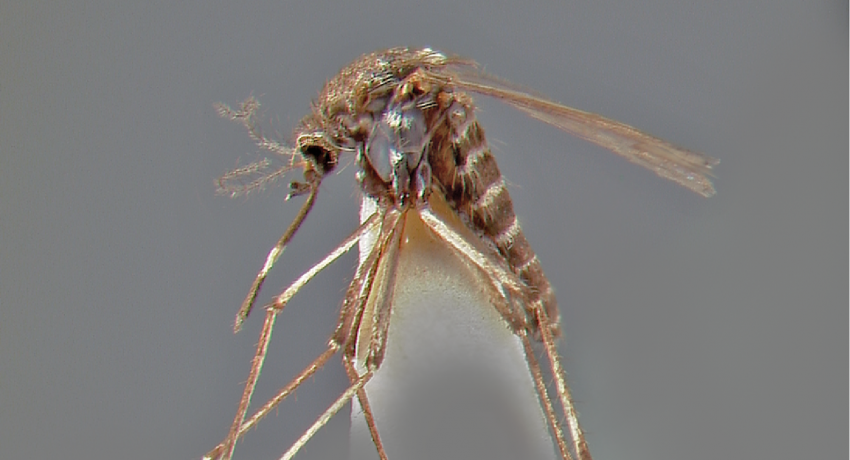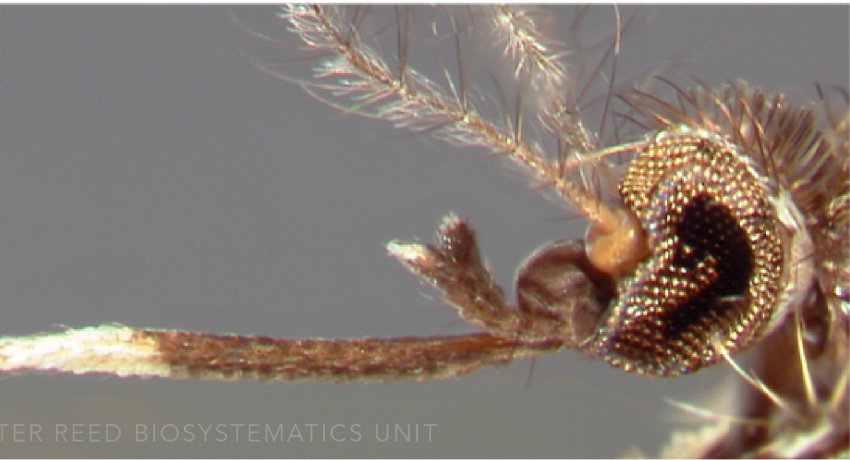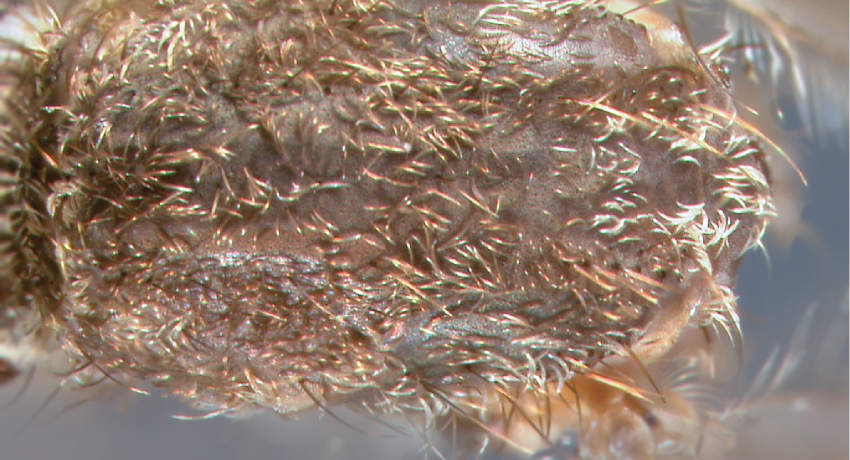INDOMALAYA (AUSTRALASIA)
Etymology: not stated [thirsty, arid, dry (L)]
Culex sitiens is primarily dark brown in color, with a large median white band on the proboscis, and pale stripes across the abdominal segments and leg joints, giving an almost wasp-like appearance. Originally described from the Indonesian island of Sumatra, Cx. sitiens has a complex taxonomic history and 14 synonyms. Culex sitiens is one of six recognized species in the Sitiens Subgroup, which also includes Cx. alis Theobald, Cx. annulirostris Skuse, Cx. litoralis Bohart, Cx. palpalis Taylor, and Cx. whitmorei (Giles).
Type locality: Sumatra [Indonesia]
Type depository: Universitetets Zoologiske Museum, Copenhagen, Denmark (ZMC)
DIAGNOSTIC CHARACTERS (Click photos to view; mouse over and click large photo to zoom in.)
ADULT (illustrated): Head: Proboscis with broad median pale area; vertex all brown-scaled. Thorax: Scutum with dark brown scales and small pale scale patches on margins and on prescutellar area; acrostichal setae present. Pleuron with distinct patches of scales; lower mesepimeral setae absent. Wing: Wing dark-scaled; vein R2+3 shorter than vein R2. Legs: Fe-I,II speckled anteriorly; Ta-I–III with pale bands at articulations.
LARVA (not illustrated): Head: Seta 1-C evident and flattened; setae 2,3-A subapical on antennal shaft. Terminal segments: Pecten on basal 0.2–0.34 of siphon; pecten spines with ˜9 fine lateral barbs; saddle longer than anal papillae.
TAXONOMIC KEYS
Yamaguti & LaCasse 1950a
Ramalingam 1976
Harbach 1988
Lee et al. 1989a
Jupp 1996
Tanaka 2004a
Rattanarithikul et al. 2005
Becker et al. 2010
![]()
WRBU – Culex (Cux.) - Australasian Region – Larva
![]()
WRBU – Culex (Cux.) - Indomalayan Region – Adult
![]()
WRBU – Culex (Cux.) - Indomalayan Region – Larva
![]()
WRBU – Culex (Cux.) - Oriental Region – Adult
![]()
WRBU – Culex (Cux.) - Oriental Region – Larva
![]()
WRBU – Culex (Cux.) - Eastern Palearctic Region – Adult
![]()
WRBU – Culex (Cux.) - Eastern Palearctic Region – Larva
Exemplar DNA sequences
Cx. sitiens COI: AB738201–02, AB738205–06, AB738271, DQ154161, DQ154163, DQ310144, JQ728396–98, JQ728400, JQ728402, MK300239, MK300241–44
BIONOMICS
Immatures
Females deposit large egg batches (mean 158, range 103–223), and neonates develop to adults in 8–12 days, therefore population densities can rapidly increase. Both males and females are long-lived, and the species is multivoltine. Autogeny was noted in 1% of females fed on high sucrose diets (25% sucrose) in the laboratory, but this was deemed unlikely in nature. Immatures of Culex sitiens occur in sunlit fresh, brackish, and seawater habitats in coastal mangrove and Nipa swamps and tidal marshes, especially where waterbodies are polluted with trash. These can include puddles, ditches, rockpools, ponds, crabholes, water collections in boats, and some smaller trash containers (e.g. cans, jars) close to populated coastal areas. The anal gills of the larvae are short and bulbous, which is believed to be an adaptation to salinity.
Adults
Culex sitiens females bite throughout the night with a single peak between 19:00 and 20:00. Although the species reportedly feeds on birds and pigs, human biting rates of 135 bites/person/hour have been reported in Thailand, indicating that it is a significant pest nuisance. In the South Pacific, Cx. sitiens is a ferocious man-biter. Adults are readily caught in light traps, in cow-baited traps and at human bait.
DISTRIBUTION NOTES
Australia, Borneo, Bangladesh, Cambodia, Cameroon, Comoros, Djibouti, Egypt, Ethiopia, Fiji, French Polynesia, Guam, Hong Kong, India, Indonesia, Iran, Japan, Kenya, Madagascar (includes Glorioso & Juan De Nova Is), Malaysia, Maldives, Mariana Islands, Morocco, Mozambique, Myanmar, Nauru, New Caledonia, New Hebrides, Nigeria, Oman, Pakistan, Palau, Papua New Guinea, People's Republic of China, Philippines, Polynesian Islands (Howland, Jarvis, Johnston Atol, Pitcairn, Wallis & Futuna), Samoa (Ind. State of Samoa; American Samoa; Western Samoa), Saudi Arabia, Senegal, Seychelles, Sierra Leone, Singapore, Solomon Islands, South Korea, Sri Lanka, Sudan & South Sudan, Taiwan, Tanzania, Thailand, Timor, Tonga, Tuvalu, United Arab Emirates, Vanuatu, Vietnam, Yemen, Zambia.

WRBU VECTOR HAZARD REPORTS
None; View other WRBU Vector Hazard Reports
Available GIS Models:
IMPORTANT REFERENCES (full citations below)
Wiedemann 1828: 542 (F)
Barraud 1924m (L*)
Edwards 1941: 296 (M*, F), 417 (P)
Williams 1943: 215 (F*, L*)
Bohart & Ingram 1946b: 18, 32, 81 (M*, F, L*; bionomics, distribution, taxonomy)
Penn 1949b: 80 (P*)
Yamaguti & LaCasse 1950a: 30, 85-86 (M*, F*, L*; taxonomy, keys, bionomics, distribution; Guam)
Iyengar & Menon 1955: 7 (M*, L*)
Mattingly & Knight 1956: 104 (F, L; taxonomy)
Delfinado 1966a: 151 (M*, F, L*; synonym)
Bram 1967b: 239 (M*, F*, P*, L*; bionomics, distribution, taxonomy)
Lotfi 1970: 401 (distribution)
Aslankhan 1971b: (distribution)>
Basio 1971b: 59 (M*; bionomics)
Maffi & Taylor 1974: 207 (distribution)
Baisas 1974: 101 (M, F, P, L; taxonomy, bionomics, distribution; Philippines)
Tanaka et al. 1975c: 218 (taxonomy, bionomics, distribution)
Rickenbach et al. 1976: 96 (distribution)
Sirivanakarn 1976: 95 (M*, F*, P*, L*; distribution)
Ramalingam 1976: 308 (taxonomy, biononomics, keys, distribution; Samoa & Tonga)
Brunhes 1977a (distribution; Comoros Island)
Tanaka et al. 1979: 155 (M*, F*, L*)
Chadee & Bennett 1988 (E*)
Harbach 1988: 87 (M*, F, P*, L*; taxonomy, complete synonyms, keys, bionomics, distribution)>
Lee et al. 1989a: 225 (F key, taxonomy, bionomics, distribution, review)
Jupp 1996 (M*, F*; key)
Whelan & Hapgood 2000
Trari et al. 2002: 331 (distribution; Morocco; as mauritanicus)
Tanaka 2004a: 28 (P*; taxonomy, key)
Rattanarithikul et al. 2005 (F*, L*; bionomics, distribution, keys)
Becker et al. 2010: 366 (F*, L*; key, taxonomy, distribution, bionomics)
CURRENT SYNONYMS
syn. impellens Walker
1859: 91 (F). Type locality: Makessar, Celebes [Sulawesi] (NHMUK).
syn. microannulatus Theobald
1901a: 353 (M*, F*). Type locality: Quilon, Travancore, Madras & Shahjahanpur, [United] Provinces, [India] (NHMUK).
syn. bancroftii Theobald
1901a: 367 (F*; as ssp. of Cx. annulirostris). Type locality: Burpengary, Queensland, Australia (NHMUK). References: Stone et al. 1959: 241 (syn.); Lee et al. 1989a: 225 (to syn. with sitiens by E.N. Marks).
syn. gnophodes Theobald
1903a: 163 (F). Type locality: Bruas, Dindings, Malaya [Malaysia] (NHMUK).
syn. somaliensis Neveu-Lemaire
1906: 254 (M*, F*). Type locality: Djibouti, French Somaliland (NE?).
syn. nigricephala Leicester
1908: 149 (M, F). Type locality: Batu Gajah, [Perak], Malaya [Malaysia] (NE).
syn. salus Theobald
1908c: 256 (M*, F*). Type locality: Port Sudan, [Kassala], Sudan (NHMUK).
syn. jepsoni Theobald
1910b: 158 (F*). Type locality: Suva, [Viti Levu], Fiji (NHMUK).
syn. saibaii Taylor
1912b: 28 (F). Type locality: Saibai Island, Torres Strait (ANIC). References: Lee et al. 1989a: 225 (type info.).
syn. paludis Taylor
1913: 56 (F; Culicelsa). Type locality: Townsville, Queensland, Australia (ANIC). References: Lee et al. 1989a: 225 (type info.).
syn. milni Taylor
1914d: 196 (M*, F; Culicelsa annulirostris var.). Type locality: Milne Bay, Papua, New Guinea (ANIC). References: Lee et al. 1989a: 225 (type info.).
syn. annulata Taylor
1914c: 689 (M, F*; Culicada). Type locality: Townsville, Queensland, Australia (ANIC). References: Lee et al. 1989a: 225 (type info.).
syn. salinus Baisas
1938: 204 (M*, F*, P*, L). Type locality: Caloocan, Rizal, Luzon, Philippines (NE).
syn. mauritanicus Callot
1940: 362 (L*). Type locality: Taghjicht, [Grand Atlas Region], Morocco (IPS). References: Harbach 1988: 87 (lectotype desig.).
CITED REFERENCES
Baisas, F. E. (1938). Notes on Philippine mosquitoes. VII. A. Culex (Culex) with banded proboscis and tarsi. B. Anopheles: the pupae of three rare species; the Leucosphyrus-subgroup. Monthly Bulletin of the Bureau of Health, 18(5), 175–232.
Baisas, F. E. (1974). The mosquito fauna of Subic Bay Naval Reservation, Republic of the Philippines. San Francisco: Headquarters, First Medical Service Wing (PACAF), San Francisco.
Barraud, P. J. (1924m). A revision of the culicine mosquitoes of India. Part XVII. Indian Journal of Medical Research (Calcutta), 12, 427–434.
Basio, R. G. (1971b). The mosquito fauna of the Philippines (Diptera, Culicidae). Manila: National Museum of the Philippines. 198pp.
Becker, N., Petrić, D., Zgomba, M., Boase, C., Madon, M., Dahl, C., & Kaiser, A. (2010). Mosquitoes and their control (Second ed.). Berlin Heidelberg: Springer-Verlag.
Bohart, R.M., & Ingram, R.L. (1946b). Mosquitoes of Okinawa and islands in the Central Pacific. In United States NAVMED (Bureau of Medicine and Surgery, Navy Department) (pp. 110). Washington.
Bram, R.A. (1967b). Contributions to the mosquito fauna of Southeast Asia. II. The genus Culex in Thailand (Diptera: Culicidae). Contributions of the American Entomological Institute, 2(1), 1–296.
Brunhes, J. (1977a). Les moustiques de l'archipel des Comores I. Inventaire, repartition et description de quatre espèces ou sous-espécies nouvelles. Cahier ORSTOM. Série Entomologie Médicale et Parasitologie, 15(2), 131–152.
Callot, J. (1940). Sur quelques moustiques du Maroc. Archives de l'Institut Pasteur du Maroc, 2, 361–365.
Chadee, D.D., & Bennett, H. (1988). Description of Culex sitiens eggs from Oman (Diptera: Culicidae). Mosquito Systematics, 20(3), 370–373.
Delfinado, M.D. (1966a). The culicine mosquitoes of the Philippines, tribe Culicini (Diptera, Culicidae). Memoirs of the American Entomological Institute, 7, 1–252.
Edwards, F.W. (1941). Mosquitoes of the Ethiopian Region. III. Culicine adults and pupae. Bulletin of the British Museum (Natural History) Entomology.
Harbach, R.E. (1988). Mosquitoes of the subgenus Culex in southwestern Asia and Egypt (Diptera: Culicidae). Contributions of the American Entomological Institute, 24(1), 1–240.
Iyengar, M.O.T, & Menon, M.A.U. (1955). Mosquitos of the Maldive Islands. Bulletin of Entomological Research, 46, 1–10.
Jupp, P.G. (1996). Mosquitoes of southern Africa. Culicinae and Toxorhynchitinae. Ekogilde Publishers, Hartebeespoort, South Africa, 156pp.
Lee, D.J., Hicks, M.M., Debenham, M.L., Griffiths, M., Marks, E.N., Bryan, J.H., & Russell, R.C. (1989a). The Culicidae of the Australasian region. Volume 7. Commonwealth Department of Health, School of Public Health and Tropical Medicine Monograph Series, 2.
Leicester, G.F. (1908). The Culicidae of Malaya. Studies from the Institute for Medical Research, Federated Malay States, 3(3), 18–261.
Maffi, M., & Taylor, B. (1974). The mosquitoes of the Santa Cruz faunal subarea of the Southwest Pacific (Diptera: Culicidae). Journal of Medical Entomology, 11(2), 197–210.
Mattingly, P.F., & Knight, K.L. (1956). The mosquitoes of Arabia. I. Bulletin of the British Museum (Natural History), 4(3), 89–141.
Neveu-Lemaire, M. (1906). Étude des culicides africains (mission du Bourg de Bozas en Afrique tropical). Archives de Parasitologie, 10, 238–288.
Penn, G.H. (1949b). The pupae of the mosquitoes of New Guinea. Pacific Science, 3, 3–85.
Ramalingam, S. (1976). An annotated checklist and keys to the mosquitoes of Samoa and Tonga. Mosquito Systematics, 8(3), 298–318.
Rattanarithikul, R., Harbach, R.E., Harrison, B.A., Panthusiri, P., Jones, J.W., & Coleman, R.E. (2005). Illustrated keys to the mosquitoes of Thailand. II. Genera Culex and Lutzia. Southeast Asian Journal of Tropical Medicine and Public Health, 36 (Supplement 2), 1–97.
Rattanarithikul, R., Harrison, B.A., Panthusiri, P., & Coleman, R.E. (2005). Illustrated keys to the mosquitoes of Thailand. I. Background; geographic distribution; lists of genera, subgenera, and species; and a key to the genera. Southeast Asian Journal of Tropical Medicine and Public Health, 36(1), 1–80.
Rickenbach, A., Eouzan, J.-P., Ferrara, L., & Bailly-Choumara, H. (1976). Données nouvelles sur la presence, la frequence et la repartition des Toxorhynchitinae et Culicinae (Diptera, Culicidae) au Cameroun, 2. Genres Eretmapodites et Culex. Cahier ORSTOM. Série Entomologie Médicale et Parasitologie, 14(2), 93–100.
Sirivanakarn, S. (1976). Medical entomology studies - III. A revision of the subgenus Culex in the Oriental region (Diptera: Culicidae). Contributions of the American Entomological Institute, 12(2), 1–272.
Stone, A., Knight, K.L., & Starcke, H. (1959). A synoptic catalog of the mosquitoes of the World (Diptera, Culicidae) (Vol. 6). Washington, D.C.: Entomological Society of America, The Thomas Say Foundation.
Tanaka, K. (2004a). Studies on the pupal mosquitoes of Japan. (10) Culex (Culex) (Diptera, Culicidae). Japanese Journal of Systematic Entomology, 10(1), 9–42.
Tanaka, K., Mizusawa, K., & Saugstad, E.S. (1979). A revision of the adult and larval mosquitoes of Japan (including the Ryukyu Archipelago and Ogasawara Islands) and Korea (Diptera: Culicidae). Contributions of the American Entomological Institute, 16, 1–987.
Tanaka, K., Saugstad, E.S., & Mizusawa, K. (1975c). Mosquitoes of the Ryukyu Archipelago (Diptera: Culicidae). Mosquito Systematics, 7(3), 207–233.
Taylor, F.H. (1912b). Contribution of a knowledge of the Culicidae and Ixodidea of North Queensland and the Torres Straits. Retrieved from Queensland: pp 27–29.
Taylor, F.H. (1913). Report of the entomologist. Report of the Australian Institute of Tropical Medicine, 1911, 49–74.
Taylor, F.H. (1914c). The Culicidae of Australia. I. Transactions of the Entomological Society of London, 683–708.
Taylor, F.H. (1914d). Culicidae from Papua. Transactions of the Royal Entomological Society of London, 185–205.
Theobald, F.V. (1901a). A monograph of the Culicidae or mosquitoes (Vol. 1). London: British Museum (Natural History). 424pp.
Theobald, F.V. (1903a). A monograph of the Culicidae of the World (Vol. 3). London: British Museum (Natural History). 359pp.
Theobald, F.V. (1908c). New mosquitoes from the Sudan with list and synoptic table of all the known Sudanese species. Retrieved from Retrieved from Wellcome Research Laboratory Report, Khartoum, Sudan.
Theobald, F.V. (1910b). The Culicidae of Fiji, including two new species. Entomologist, 43, 155–159.
Trari, B., Dakki, M., Himmi, O., & El Agbani, M.A. (2002). Le moustiques (Diptera: Culicidae) du Maroc: Revue bibliographique (1916–2001) et inventaire des espèces. Bulletin de la Société de pathologie exotique (Paris), 96(4), 329–334.
Walker, F. (1859). Catalogue of the dipterous insects collected at Makessar in Celebes, by Mr. A. R. Wallace, with descriptions of new species. Journal of the Proceedings of Linnean Society, Zoology, 4, 90–92.
Whelan, P., & Hapgood, G. (2000). A mosquito survey of Dili, East Timor, and implications for disease control. Arbovirus Research in Australia, 8, 405–416.
Wiedemann, C.R.G. (1828). Aussereuropaische zweiflugelige insekten. (Vol. 1). Hamm.
Williams, F.X. (1943). Mosquitoes and some other noxious flies that occur in New Caledonia. Hawaiian Planters' Record, 47, 205–222.
Yamaguti, S., & La Casse, W.J. (1950a). Mosquito fauna of Guam: Office of the Surgeon General, Headquarters, 8th Army, APO 343. United States. 207th Malaria Survey Detachment.
CITE THIS PAGE
Walter Reed Biosystematics Unit (Year). Culex sitiens species page. Walter Reed Biosystematics Unit Website, http://wrbu.si.edu/vectorspecies/mosquitoes/sitiens, accessed on [date (e.g. 03 February 2020) when you last viewed the site].











































































































































































